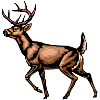Eastern Wildlife Damage Control Conferences

Eastern Wildlife Damage Control Conference: 6th (1993)
Date of this Version
October 1993
Document Type
Article
Abstract
Northeastern forests have experienced regeneration delays and/or failures due to browsing by white-tailed deer (Odocoileus virginianus). Investigations were made in north-central West Virginia to determine if the size of clearcut is correlated with degree of deer browsing, regeneration of shrubs and trees, and percent ground cover by various herbaceous plants. Tree seedlings, woody shrubs, and herbaceous ground cover were recorded in September 1992 and August 1993 on 16, 1-year-old clearcuts, ranging in size from 0.8 to 0.2 ha. Woody regeneration was categorized by species, origin, browsed or not, and vegetative height class on 25 systematically arranged sampling stations within each clearcut. Herbaceous plant cover (ferns, grasses, and sedges) was ocularly estimated as percent horizontal ground cover. All tree and shrub combined and commercial tree species for timber were species significantly taller in the 0.8-ha clearcuts than in the smaller cuts. Percent browsed was generally lower for all tree species groups and Rubus spp. in the 0.8-ha clearcuts than in the smaller clearcuts. Tree seedling diversity was relatively unaffected and percent fern cover was greatest in the 0.2-ha clearcuts. White-tailed deer use was relatively unaffected by clearcut size 1 and 2 years after harvest. If timber and wildlife are the primary objectives of small forest landowners, clearcuts smaller than 0.8-ha in size should be avoided.

